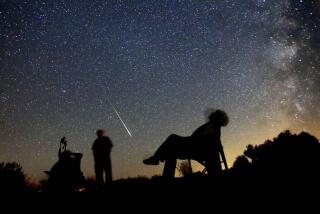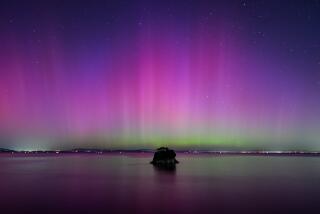Trying to see the light
- Share via
VOGAR, ICELAND — Iceland is famous for two kinds of night life. One is the manic weekend reveling in the capital, Reykjavik, where young folk stream from bar to bar in the narrow cobblestone streets, drinking, dancing and striking occasional sparks until daybreak.
The other night life takes place 60 miles above this austere volcanic island, where electrons and protons cast off by the sun collide with particles in the upper atmosphere to produce an effect more sublime than that on the ground: the aurora borealis, or northern lights.
In late December, I accompanied a friend in hopes of experiencing the second version. We had watched a DVD titled “Aurora Borealis: The Magnificent Northern Lights,” 72 minutes of gorgeous geomagnetic disturbance backed by a soundtrack from Gustav Holst’s “The Planets.”
Iceland seemed the ideal auroral stamping ground. At 66 degrees latitude, it is usually in the brightest swath of the auroral zone encircling the north pole. Its treeless terrain would provide clear views. And it boasts the little urban gem of Reykjavik as a daytime counterpoint.
We had booked our tickets from Boston in early November -- $577, taxes and fees included -- to take advantage of the fall of the Icelandic krona. Nearly seven weeks later, on a moonless Saturday, we gathered in the village of Vogar, 27 miles from the lights of the capital. Swaddled in down and layers of warm clothing, I sat in a grass-covered lava field, staring up at the darkness, waiting.
--
Auroras are always shimmering somewhere over the polar regions. They occur most frequently in a 1,500-mile radius centered on the Earth’s off-center geomagnetic poles, between 60 and 70 degrees north and south latitude. Seen from space, they look like a radiant tonsure circumscribing the top and bottom of the planet.
Auroras demonstrate the possibilities of plasma physics in a celestial laboratory. In the upper fringes of the Earth’s polar atmosphere, high-energy electrons and protons bombard oxygen and nitrogen. The gases emit tiny flashes of light in the process, similar to the discharge in a neon sign.
Their sheer variety confounds scientists: They can appear as arcs, bands, drapery, curtains, veils, coronas, rays, swirls, angel wings and gauzy clouds. They can wave, turn, pulsate, blink, flicker and flame. Although the most common colors are green (from oxygen atoms) and red (from nitrogen molecules), auroras can glow violet, yellow and blue. There are even black auroras, which look as if paint has been splattered across the firmament.
Though Galileo coined the term “aurora borealis” for the northern lights in 1619 and speculated (incorrectly) on their origins, myths have always abounded.
Depending on the culture, auroras have been interpreted as torches wielded by friendly giants, reflections of light from distant schools of herring, the highest level of heaven, souls of maidens, spirits of the stillborn, portents of war and pestilence.
Science has whittled down such fantasies. Today, we know that auroral abundance or scarcity tracks the 11-year sunspot cycle. During the so-called solar maximum -- when sunspots, solar flares and dramatic “coronal mass ejections” tend to peak -- earthly auroras are brighter and more extensive, reaching farther from the magnetic poles to lower latitudes.
Today, we are emerging from the trough of the solar cycle, with auroras expected to start picking up this year. The sun’s activity will peak again in 2012 or 2013.
But that doesn’t necessarily mean this is the off-season. You can see auroras during solar minimums and miss them during solar maximums. Particles continuously stream from the sun and light up the sky somewhere.
If you are planning a trip and want to improve your chances of witnessing the spectacle, the science of space weather -- environmental conditions in outer space that affect Earth -- comes in handy.
--
For modern aurora chasers, space weather prediction has changed the nature of the quest. Government and academic websites feature not only seven-day forecasts of the lights, but also hourly prognostications. Travelers can be apprised daily of solar restlessness and its probable effects on auroral activity. Serious sky watchers can even arrange for cellphone and e-mail alerts about imminent auroral displays.
One such popular website is operated by the National Oceanic and Atmospheric Administration’s Space Weather Prediction Center (www .swpc.noaa.gov). In this data-laden resource, aurora watchers can check out satellite-generated auroral maps of the north and south poles, three-day forecasts of stirrings on the sun and in the Earth’s magnetic field, and the all-important Kp index, which ranges from 0 to 9 and reflects disturbances in geomagnetic activity.
To figure out whether you have a decent shot at seeing an aurora, you first look up your magnetic latitude (which is different from geographic latitude) and determine how high the Kp index must be for you to see an aurora at your locale. Then you check the site’s 24-hour forecast to see whether magnetic “storms” are brewing. If the numbers augur well and the sky is dark, pray for clear weather.
The Geophysical Institute at the University of Alaska Fairbanks has a more user-friendly site ( www.gedds.alaska.edu/AuroraForecast) that provides a week-long global aurora forecast in both picture and text form, as well as an hourly aurora forecast.
For the technologically addicted, several services offer up-to-the-minute aurora alerts, based on the Kp index.
For $4.95 a month, Spaceweather Phone ( www.spaceweather.com) will call you two days in advance of geomagnetic storms (for example, when a coronal mass ejection is hurtling toward Earth) and when such a storm over your location is strong enough to trigger an aurora. The Geophysical Institute also offers free e-mail alerts.
Perhaps the most timely and reliable service is Aurora Chasers ( www.aurorachasers.com), which will send you e-mail, pager or cellphone alerts for free. The notifications are sent 30 to 60 minutes ahead of the event, giving you time to set up a camera, as well as saving you hours of fruitless observation.
“I like sleep, and I didn’t want to spend wasted nights going out to find there was nothing there,” said Aurora Chasers founder Mark Simpson. This computer scientist who unexpectedly caught his first light show while driving in Canada vowed to bring the same sense of wonder to others. “It’s a life-changing experience,” he said.
Simpson bases his predictions on data streamed by a government satellite that measures the solar wind and the strength of the Earth’s magnetic field. The briefly worded text messages report the Kp strength of imminent auroras, and when they will unfold and taper off. Subscribers determine the threshold at which they want to be alerted -- whether it’s a relatively weak aurora that hugs the horizon or a breathtaking display that reaches overhead.
About 6,700 sky-watchers subscribe. “The vast majority are people who have never seen an aurora in their lives and want to see it,” Simpson said.
Like me, many are travelers who want to boost the prospects of success once they arrive at their chosen observation post. Some are hotel operators in Alaska and Canada who cater to aurora cognoscenti. A few are cheesy romantics who use the service to schedule marriage proposals under the flashing heavens.
--
I had figured that Iceland’s northerly locale and late-December new moon augured well for aurora watching. As I neared my travel date, I checked the aurora forecast websites to fine-tune my expectations -- and my optimism dimmed. The day of my departure, the NOAA Space Weather Prediction website said that “Solar activity is expected to be very low” and that “Geomagnetic field activity is expected to be at quiet levels during the forecast period,” which, I noted with a sinking feeling, coincided with my trip.
The Geophysical Institute was equally downbeat. During my stay, it called for auroral conditions ranging from “quiet” to “minimal.”
Put another way, I would be in Iceland during a short-term geomagnetic trough within the long-term trough of the solar cycle: the lowest of the low. In aurora-chaser denial, I phoned NOAA space scientist Christopher Balch for some encouraging words. He had a soothing bedside manner.
“Am I really in the trough of the trough?” I asked.
Balch set down the phone, tapped on his computer keyboard, checked some data, and picked up again. “We’ve seen a couple Kps of 3 today, but unfortunately it’s going to quiet down tomorrow and into the next few days,” he said. “I’m afraid you’re in a long-shot situation.”
“What do you mean by ‘long shot’?”
“Probably around a 10% chance.”
I was desperate. “Chris, in your forecasting experience, have you seen any big surprises? Have you ever predicted nothing and then a magnificent aurora happened?”
“Hmmm. Ah boy. Hmmm. Yeah. That’s a tough question,” he said.
The aurora gods were not smiling on me.
--
On the first night of aurora watching in Vogar, the clouds briefly parted about 1 a.m. to reveal Orion and other stellar delights -- but no auroras. On the second and third nights, clouds obscured even the most long-shot sightings. The only lights I consistently saw were Christmas decorations.
On the day I left, the local newspaper ran a full-page advertisement from a local book and stationery store, wishing its customers a prosperous new year. The ad featured a photograph of a fat, comma-shaped green-white aurora against a blue-black sky. The image was similar to the framed photo our innkeeper kept in a display case, which showed a green aurora illuminating the sky over the motel’s canted roof line. The image had been shot by a guest just the year before.
Next time, I’ll plan my trip for the month on either side of the equinoxes, when auroras are more common. I’ll stay a week to compensate for unexpected bad weather. I’ll head inland, where clear skies are more likely.
And if the celestial lights still fail? Then I’ll check out Reykjavik’s other night life.
--
More to Read
Sign up for The Wild
We’ll help you find the best places to hike, bike and run, as well as the perfect silent spots for meditation and yoga.
You may occasionally receive promotional content from the Los Angeles Times.






